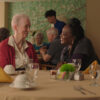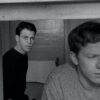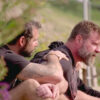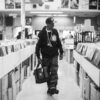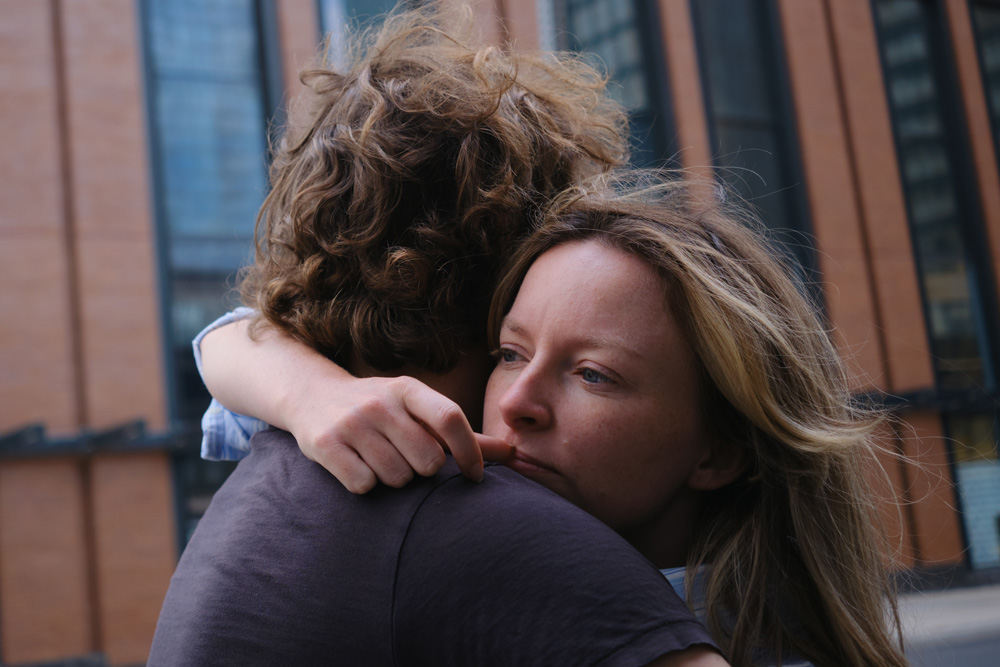Only on a Kazik Radwanski production could a day in which filming at Niagara Falls would seem like an average one, but Nikolay Michaylov wasn’t fazed at having limited time to capture a critical scene at the natural wonder in “Matt and Mara,” knowing he could expect the unexpected. On their last collaboration “Anne at 13,000 Feet,” the cinematographer had to figure out how to cover the film’s star Deragh Campbell on an epic skydive for its harrowing opening scene, giving it the kind of consideration that only the makers of “Mission Impossible” usually have to figure out, not a scrappy indie, but when that kind of exercise is bound to build trust between an actor, a director and a cinematographer, Michaylov wasn’t sweating it this time around.
“Weirdly, there wasn’t a lot of pressure because Dan [Montgomery] and Candice [Napoleone], our producers, secured some permit that allowed us to shoot in and around the Falls and there was a lot of excitement for that day, but we didn’t scout it and we didn’t know what it would look like,” said Michaylov, whose preparation mostly consisted of figuring out how to protect the camera equipment from getting wet. “We just looked at some films that shot under the Falls and some tour guide photos online, but a lot of that shoot embodies what it’s like to shoot a Kaz film. You look around, you talk about it and then you jump in.”
That there would be little difference for Michaylov shooting amidst one of the world’s greatest waterfalls or simply out on the streets of Toronto, a base of operations for Radwanski and his film collective MDFF, is a feature and not a bug of the types of dramas they’ve made together and the type that the cinematographer has made generally where everyday life has a way of coming at characters with a ferocity that can typically only be expected when disaster strikes. Filmed mostly in the daylight, “Anne at 13,000 Feet” could come across as a waking nightmare for its lead character, a school teacher so tightly wound from carrying anger around place to place that to stay close to her was to keep as intense a grip as she wanted to have on the world in front of her. Things would seem to a bit breezier at first in the trio’s followup “Matt and Mara” at first for Mara (Campbell), a tenured professor in an unexciting but stable marriage, but even before reaching Niagara Falls, it turns out to be a prelude to monsoon season upon a visit from an old friend from college (“Blackberry”’s Matt Johnson), an agent of chaos all on his own, but bringing back history that Mara would rather not remember both professionally when he found success as an author that eluded her and personally when it would seem a romance was inevitable, but never consummated.
Despite a clear eye for striking individual compositions, what astounds about Michaylov’s work is the energy his imagery holds, whether it’s in his collaborations with Radwanski where the camera usually takes on the anxious shuffling of its characters or with the immigration dramas of Antoine Bourges (“Concrete Valley” and “Fail to Appear”) in which the seemingly immoveable bureaucracies of the state may dictate a stationary frame, but the restlessness of those caught within is allowed to burst through nonetheless. With his signature something that’s felt more than seen, he has become the largely unheralded backbone of an exciting new wave of filmmakers from Canada in the decade since picking up a camera professionally, culminating in a particularly noteworthy 2024 when not only “Matt and Mara” is arriving in theaters after premiering earlier this year at Berlinale, but he also shot “Measures for a Funeral,” Sofia Bohdanowicz’s captivating capstone to the ongoing adventures of researcher Audrey Benac (Campbell, once more), who has long put the present at arm’s length while investigating the past and delves into the archives of violinist Kathleen Parlow amidst discord in her own life, that premiered last month at TIFF.
Recently, Michaylov took the time to talk about how he ended up leaving behind a safe career in crunching data to throw caution to the wind as a filmmaker, finding the right collaborators and growing alongside them.
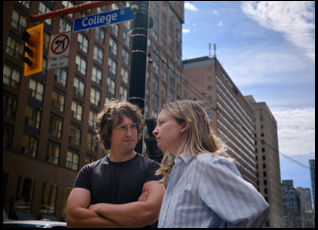
I actually studied computer science and business in university, and it was something that I was ushered into when I was in high school, just because I excelled at that. But the arts were also something that I had an interest in, and no one really talked about how you can make a career out of it. In high school, we had a darkroom and I was shooting photos and there was a video class that I was part of as well, but then I was also taking my math and my computer science and computer engineering [seriously]. Also with skateboarding, that technology is something I was around quite a bit and I hated the program I was in — I had a full scholarship to this program at TMU, and I just felt out of place, and I was still interested in watching movies and making movies, so I decided to make the switch to go to film school.
It wasn’t the most straightforward path and I actually ended up working in IT for a few years while I worked on my portfolio and got accepted into the TMU film program. I had a really naive sense of what filmmaking was. I thought filmmakers did it all — shot the films, directed the films and edited the films. I didn’t realize that there were other crew roles, like a production designer, a costume designer, an editor, and coming from this technical background, cameras were an easy tool for me to use, and I think my peers saw that, and then they just started to ask me to shoot their films. It just blossomed from there.
It seems like you did fid your crowd with the MDFF crew. How did you come to collaborate?
There’s a bit of luck involved there. One of my professors James Warwick noticed my interest and my ability, and Kaz [Radwanski] had just wrapped up his first feature “Tower” and was looking for a new cinematographer because his previous cinematographer was moving out of filmmaking, and James made the connection between Kaz and I, and also Dan Montgomery, who produces all of Kaz’s work. We met at a coffee shop, the vibes were good, and then they asked me to work on some corporate videos to see if we would click in a working environment. Those videos were low stakes, and then I think Kaz kind of just liked my vibe and my filmmaking instincts as well, and he soon after asked me to shoot a short film called “Cutaway,” [which] was a really positive working experience and then he asked me to shoot “How Heavy This Hammer,” which is his second feature, but the first I ever shot, and it snowballed from there.
Something I know that’s interesting about the way that collective operates is that they own their own camera and appear to have grown more sophisticated on a technical level. Has that been an interesting evolution?
It’s funny, because Dan Voshart, their previous cinematographer, had this old Panasonic camera that they shot “Tower” on and Kaz liked the idea of self-sufficiency with filmmaking, so before “Cutaway,” I was actually consulting on the camera that they should buy and between Dan, Kaz, and I, that was a bit of a collaborative effort. We actually ended up testing an array of cameras and figured out which was the best one for our working model and we used that camera on “Cutaway,” “How Heavy is This Hammer,” “Scaffold,” and “Anne at 13,000 Feet.” The package built from film to film, but for the new one “Matt and Mara,” we invested in a new camera and again, I was part of the consultation. I’d grown significantly as a cinematographer, so I knew what tools would elevate our process and work in tandem with our growing filmmaking process.
Before we were shooting on a 1080 C300 Mark I, and now we’ve jumped to a RED Komodo that records up to 6K and with the new film, we were thinking of future-proofing our work moving forward. Because we were completely capable with the old technology, but bringing a 1080 image onto a 4K screen can start to look a little funny, so we made that jump.
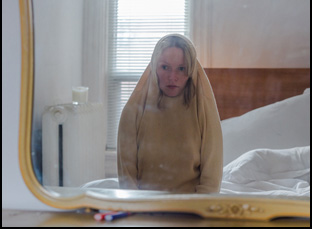
It’s changed a little bit. We still want to stick to this ethos of filmmaking on self-sufficiency and guerrilla-style movement, but the difference between even “Anne” and “Matt and Mara” is that I had a camera assistant on this film, which doesn’t sound super crazy with respect to how I typically operate on a film set where I have a whole camera team and a whole grip and lighting team, but it’s one that works for Kaz and I at the pace that we shoot. I don’t think working that way works for everyone. We’ll shoot one scene a day sometimes that we’ll chip at for six hours and I think on a traditional film set, you’re trying to squeeze four to six scenes a day. I think the Canadian average is five pages a day, and I’ve heard television shows that shoot 10 pages a day and to me, that’s absurdly fast and way too much and doesn’t allow for changing things on the fly or improvising. But that’s the name of the game with Kaz. On this film, I didn’t have a gap or a key grip, but there are some sequences that were a bit more ambitious where we did contract out some local hires that I’ve worked with on other films and I think that’s a nice approach, where if the [scene] calls for it, there were resources there to bring in the help that was necessary.
Kaz mentioned recently to Filmmaker that your skateboarding background has come in handy, filming in big public settings. Did you know that would serve you well later in life?
In Toronto, for sure. A big part of Kaz’s oeuvre is his connection to Toronto. I don’t think [“Matt and Mara”] is an overtly Toronto film, but he has interests in these pockets of the city and putting characters into those pockets that could be familiar to some people and growing up skateboarding in the city, I get to know it really intimately, because I know where every skate spot is. I’m always probing for a ledge or a rail or a stair set that I want to skate, so I know how to navigate it in this way that maybe a more pedestrian approach would be passive. It’s funny, I wasn’t the person with the camera when I was skateboarding. I was the one being filmed, and my interest in cameras developed later on in my life, towards the end of high school, but [along] with music, the art of skateboarding is just a big influence on me. It’s a creative process that I don’t really look at as a sport, like some people do. I look at it as a way of expression. And there are some skateboarders that I look to for inspiration, maybe not so directly on my work, but it’s certainly an integral part of my life.
That’s something I can feel in your work where you’re really great at capturing energy – it isn’t only a part of movement, but the texture of the image. Has it been interesting finding the right visual expression?
Yeah, I approach every film so differently, but if we’re talking about “Matt and Mara,” I know what Kaz’s instincts are. The first time I ever shot with him, the number one note he was always giving me is “go closer, go closer.” And having watched “Tower,” certainly that the walkway. Every time someone watches a Kaz film, they go, “Oh wow, the camera’s really quite close,” but he likes that intimacy and that rawness. So when I jump into the cinematography seat and I start shooting a Kaz film, I know he wants that and my job is to do that as delicately as possible without interfering with the performance, but also do it in a way that feels cinematic. What excites Kaz more than anything is just having the actors and myself jump in and we go a little crazy and sometimes some really magical things can happen.
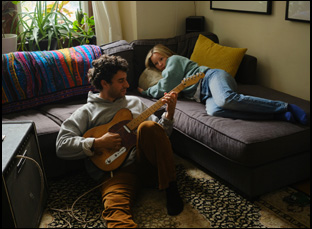
Yeah, Deragh is one of my most frequent collaborators and at this point there’s a really nice comfort around each other. We know each other’s processes and throughout all those years, we’ve also become really close friends. She just has an amazing instinct for filmmaking and performing and she really can transform into any role easily. I probably wouldn’t be involved with Sofia’s film if it wasn’t for Deragh. Sofia and Deragh wrote that film together a few years ago, and when they were discussing prospective people to shoot the film, I think Sofia was unsure because she had shot all of her own previous work and I know Deragh advocated for me quite strongly because we’ve had this history together. I’m glad that she did because that was also a really special experience. I’m super proud of that movie.
As you should be. I suspect working with Sofia was quite different than with Kazik when there’s such obvious precision.
Yeah, Sofia and Kaz are wildly different filmmakers, but at the same time when Sofia approached me to shoot her movie, she tasked me with trying to do something that she had never done. I think Sofia is so used to being the self-sufficient filmmaker, almost in the way that I was [in my early days] where I thought you had to do everything yourself. Sofia literally was, and now she had this opportunity to work with a larger team and I think it actually allowed her to explore things in a much easier way, things that weren’t possible before. And whereas Kaz and I work purely on an improvisational level, Sofia and I did months of planning, scouting, going on location, and taking photos, just like talking at length and getting into arguments about the appropriate way to shoot this movie. Then you prepare, you prepare, you prepare, and then you get to set and you forget everything. It goes out the window.
All the work that we did to prepare set us up for how to work in the space with the real actors. We had this backbone — a crazy long shotlist, and all these references. But then you block on set and Deragh brings something to set and you take that backbone and you pivot from there. So in a sense, my improvisational instincts on a Kaz film does equip me to work in a more structured environment where you plan for so long and then something goes wrong and then you have to pivot. Sophia is one of the most meticulous filmmakers I’ve ever met, but also one of the most capable when it comes to improvising herself because she’s just a problem solver.
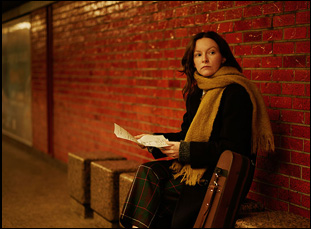
Yeah, it’s [Parlow’s] actual house, so there was a vibe there, like an energy and Sofia always talks about certain coincidences or energies. The fact that we got to shoot there was amazing, but planning that was funny because what I would do at every location is I’d take my phone and just do a little video tour. Then when we were looking at my little video tour of the house, there was a conversation that Sofia and I had [about] blocking of the scene almost [being] like a tour. There is this person who’s giving Audrey [played by Deragh Campbell] and Melanie a tour through the estate and I’m filming it like that on my phone [saying] I think the camera has to replicate that, but it also doubles as this haunting camera because we’re in her space and then Audrey is being overwhelmed by her research and what she knows about Kathleen. It was just a nice coincidence. The way we approached scouting and filming and even just experiencing that that set was really special. It’s also a pretty gnarly space, [a bit] derelict and a little neglected, so it was a weird space, but a really cool space to shoot in.
The camera really does seem to take on character in the films you’ve worked on.
Yeah, I think perspective is everything and the character is always going to be the driving force of a film. Audrey is sometimes an unreliable narrator in [“Measures for a Funeral”]. She’s the fulcrum of the film and the center of everything, but there is all this chaos around her. With “Matt and Mara,” we’re in her face and I just have to be attached to her the whole time. I always just follow the emotion. That’s always going to inform my lighting, my movements, my framing because that’s what these films are always about — is this an emotional journey?
“Matt and Mara” will have a special screening in Los Angeles via Acropolis Cinema on October 10th before starting a weeklong run at the Laemmle Royal, also opening on October 11th in San Diego at the Digital Gym Cinema and in Iowa City at Film Scene. Additional engagements include Cleveland Cinematheque on October 26th and 27th and November 6 through 10th at the Northwest Film Forum in Seattle.
